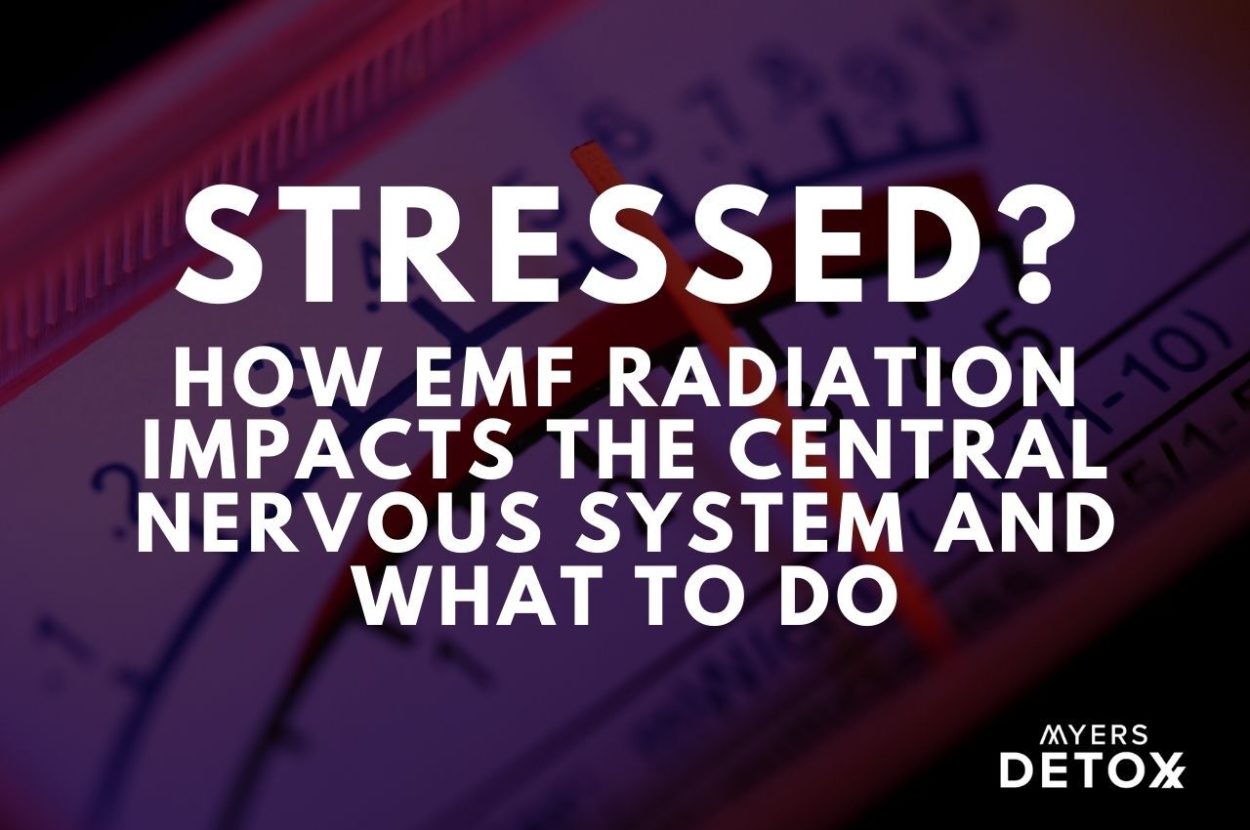People today are dealing with an unprecedented level of stress. It’s not just mental, emotional, and financial or from our fast paced lives. There is something insidious and constantly affecting and stressing our nervous systems.
No matter what you do to try to relax, EMFs from wireless internet, cell phones and dozens of other sources are ever-present, thwarting any stress reduction activities you attempt. It’s a constant uphill battle and one you need to be aware of to optimize your health.
In this article, you’ll learn:
- How EMF keeps your body stuck in permanent stress mode
- How EMFs negatively impact your hormones
- How EMFs drive up your stress response in 5 different ways
- How EMF is causing a rash of insomnia across the world
- How EMFs reduce melatonin production and sleep quality
- Do you have symptoms of chronic stress?
- Natural ways to manage both EMFs and stress
How Stress Affects Your Body
Emotional stress is one of the most common imbalances that people experience. Although you may not “feel” it like physical pain, the effects that it has on your physiology can be quite devastating.
Experiencing a stressful event or even having a stressful day here and there is a normal part of life. But when our stress response becomes chronically activated, we can begin to run into some real problems. There is a deeply rooted connection between your mind and your body, and when stress takes over your mind (and nervous system), your body immediately becomes involved.
Your stress response comes primarily from a division of your nervous system called your autonomic nervous system (ANS). Your ANS is divided further into two branches — the sympathetic nervous system (SNS) and the parasympathetic nervous system (PNS).
The sympathetic nervous system often referred to as your “fight or flight” response, becomes activated when a stressful event occurs. Its duties include (but are not limited to) increasing your blood pressure and heart rate, allowing more air into your lungs, and decreasing appetite and slowing digestion[1].
These actions of the SNS allow your body to shift into a mode that will allow you to fight off a predator. Why? Because from an ancestral perspective, that’s what the stress response was for. It’s only in modern times that a high-stakes meeting or a traffic jam would get your SNS going.
As your heart rate increases and your lungs take in more air, you can get more blood flow and oxygen to your muscles. Meanwhile, digestion and appetite go on the back burner as these are not life or death activities that need to happen when you’re face to face with a predator.
The PNS is the opposing force of the SNS, also referred to as your “rest and digest” response. The PNS is responsible for relaxing your body and getting your back into homeostasis after a stress response. This system slows your heart rate, increases digestive activity, and generally makes you feel more at ease[2].
When you’re in parasympathetic mode, you’re able to fall and stay asleep, and think more clearly and broadly. You’re also better primed for digestion and absorption of food, and to become sexually aroused, as these activities are only available to you when your mind is relaxed enough to enjoy them.
From a historical perspective, the activation of your SNS would only occur in acute bouts when a predator or other threat was present. Once the threat was gone, PNS would take over, and you would continue living your life.
In modern times, however, the predators that we deal with are much more ubiquitous. Pending bills, a stressful work environment, health issues, family dynamics, and concerns around the state of the world are not simply acute stressors, but chronic sources of unease that many people deal with.
What’s more, our lifestyles and environment tip our physiology into the category of SNS due to outside forces seemingly outside of our control. While a stressful event can activate the SNS, your SNS can also become more queued up to be activated due to factors like poor sleep, EMFs (Electromagnetic Fields from cell phones and wifi), hormones imbalances, poor diet, and more.
This sets you up for a snowball effect where life’s stressors hit you harder than they should, which further sensitizes your stress response, setting you up for even more stress.
How Stress Shows Up In Your Body and Mind
Stress shows up differently for everyone. Some of the most common side effects of chronic and acute stress include:
- Mood issues
- Brain fog
- Headache
- Muscle pain or tension
- Insomnia
- Chest pain
- Fatigue
- Restlessness
- Irritability
- Change in sex drive
- Mood issues / sadness
- Feeling overwhelmed
- Lack of motivation
Stress can also affect your behaviors and habits. When chronically stressed, people tend to put their health on the back burner and may start behaving in ways that are more aligned with the stress response than the relaxation response. Some examples include overeating, increased drug or alcohol use, social withdrawal, and exercising less.
In general, when caught in the stress response, taking care of your health feels more like a battle than an act of self-love.
EMFs and Your Stress Response
While there is little you can do to control the outside circumstances in your life, you can absolutely protect yourself from the environmental factors that are sensitizing you to the stress response.
One of the environmental factors that’s putting your stress response in high gear is EMF (electromagnetic field) radiation. There are several ways in which EMFs are causing your body to become more sensitive to stress; these include:
- Decreased Heart Rate Variability
- Increased Stress Hormones
- Negative effects on the CNS
- Increased Risk For Mood Disorders
- Poor Sleep
Decreased Heart Rate Variability
Heart rate variability(HRV) is a marker for flexibility and resilience and is often used by researchers to measure stress levels. From a technical perspective, it’s the measurement of the variation in time between each heartbeat, controlled by the autonomic nervous system or ANS.
When your ANS is in sympathetic mode, your HRV will decrease. When you’re in parasympathetic mode, it will increase. Therefore, a higher rate of variability indicates less stress, and vice versa[3][4].
Research shows that there are a number of things that can affect your HRV. These include calming practices that increase HRV like meditation and breathwork, and nervous system stimulating conditions that decrease it like stressful events, and you guessed it…EMFs[5].
How EMFs decrease heart rate variability is not completely understood. What’s clear, however, is that exposure to EMFs can affect your ANS and shift it towards the fight or flight sympathetic mode and away from the rest and digest activity of parasympathetic mode[6][7].
Increased Stress Hormones
One of the ways in which your ANS affects your stress response is through the excretion of hormones from your adrenal glands. When the sympathetic nervous system is stimulated, your adrenals release stress hormones like adrenaline, cortisol, epinephrine, and norepinephrine[8].
These hormones are the messengers that tell your body to shift into sympathetic mode — increasing heart rate, decreasing appetite, and priming your body to fight or flee.
Research shows that exposure to EMFs can lead to stimulation of adrenal gland activity via the ANS, and increased levels of stress hormones.
It appears that EMFs have a particularly potent effect on the stress hormone cortisol, which not only increases your stress response but can also result in weight gain, depressed immunity, and issues with your reproductive system[9][10][11].
Effect on CNS
Along with your autonomic nervous system, EMFs also have an effect on another part of your nervous system called your central nervous system (CNS).
Your CNS consists of your brain, spinal cord, and nerves that branch off to different parts of your body. Chemical messengers from your brain are transmitted through your nerves as electrical signals to integrate external and internal stimuli. You can think of your CNS as a highway for communication throughout your body, controlling behavior and cognition.
Your CNS is particularly vulnerable to EMF radiation due to its electrical nature[12].
When your CNS is out of balance, it can lead to a host of issues related to brain function. Some examples include impaired memory and reduced cognition. These changes can further drive your stress response, leading to the snowball effect previously mentioned[13].
What’s more, animal studies show that EMF radiation can directly increase symptoms of stress like mood issues and insomnia[14].
Additionally, many people report tingling and numbness in areas exposed to EMF because they affect your CNS.
Increased Risk For Mood Disorders
EMFs appear to have a direct effect on neurotransmitters that are responsible for a stable mood. Of course, the state of your mind is very much tied to your stress response. Can you remember the last time you felt depressed or overwhelmed? You likely wouldn’t say that you felt “at ease” or that your stress was low in these situations.
EMFs can impact the function of the neurotransmitters that you need to maintain a stable mood, specifically serotonin, and dopamine.
In one study, mice exposed to EMFs experienced a decrease in the neurotransmitter dopamine. Dopamine is a feel-good neurotransmitter that is an integral part of your reward system. It’s stimulated when your pleasure centers light up, providing you with a sense of satisfaction[15].
Another study found that rats exposed to EMFs experienced significant drops in the neurotransmitter serotonin. Serotonin is responsible for stabilizing your mood and providing feelings of wellbeing[16].
Most importantly, however, is the role that serotonin plays in helping your body adapt to stress[17]. As a way to stabilize your stress response, serotonin is released to coordinate coping responses in your physiology[18].
Therefore, if EMFs are increasing your susceptibility to stress and also inhibiting your serotonin response, they are effectively burning the candle at both ends when it comes to your ability to maintain a state of wellbeing.
Poor Sleep
The connection between getting enough sleep and your stress response cannot be understated.
In order for your body and mind to function optimally, you must get a proper night’s sleep. Without it, your entire system is vulnerable to ups and downs. While you sleep, your body recharges itself, repairing tissues, storing information, and regenerating cells. When you wake rested, you’re more likely to have a positive mood, your immune system is stronger, and your mind is sharper[19].
On the other hand, poor sleep can compound your stress response. In fact, 21% of people report feeling more stressed after a poor night of sleep. Therefore, if you want to be able to deal with everyday stressors, a good night of sleep is crucial[20].
While many people in modern society struggle with sleep issues, there is a general lack of understanding when it comes to how your body signals that it’s time for bed. Your body is, in fact, controlled by an internal clock called your circadian rhythm. This clock, which works on a 24-hour time frame, is sensitive to inputs like light, food, and activity.
When your circadian rhythm is working optimally, you’ll fall asleep like a baby and wake rested. One of the primary hormones that assists your circadian rhythm in its sleep cycle is melatonin. When your body senses that it’s night time, your melatonin levels rise. Melatonin then signals your body to relax and makes you feel sleepy[21].
But here’s the trick; in order for your body to signal the release of melatonin, it must sense a lack of sunlight. Makes sense, right? If the sun is still up, why produce melatonin and get the body sleepy?
Research shows that EMFs can inhibit the release of melatonin due to the fact that your body senses these frequencies as light. That means that you could be sitting in your home at 9 pm, pitch dark outside (maybe even laying in bed with the lights completely off), but if your WiFi is streaming through your home, your body could be sensing daylight[22].
This lack of melatonin leads to a poor night of sleep, which then translates into a poor ability to handle stress the following day.
How To Combat EMFs and Stress Naturally
I’ve tried dozens of EMF protection and mitigation devices over the years. There are a lot of devices that don’t work. But I have a few suggestions I recommend to reduce the harmful impact of EMFs on your mind and body.
A few practices to start with include:
- Unplugging your WiFi at night
- Turning off Bluetooth on your phone when you don’t need it
- When not using your phone, keep it on airplane mode
- Remove electronics from your bedroom
- When working on your laptop, don’t charge it while you’re using it
- Use grounding techniques like walking barefoot on the earth, yoga, and deep breathing to counter the effects of EMF
- Do not charge your phone next your bed when you’re sleeping – charge it in a different room
- Unplug any appliances you aren’t using
- Turn off the circuit breaker in your bedroom at night to mitigate dirty electricity
All of these practices will help you minimize your exposure to EMFs, however, the easiest way that I’ve found to minimize the effects of stress caused by EMF is by wearing a Harmoni Pendant. It’s a cool piece of functional jewelry I’ve used for years.
The Harmoni Pendant is a wearable pendant that goes with you everywhere – at work, a friend’s home, the grocery store. As long as you’re wearing your pendant you can rest assured that you’re reducing the harmful effects of EMFs on your body.
In fact, research shows that this small, yet powerful pendant can reduce the stressful effects of EMFs on average by 48%.
What’s more, a recent study of the Harmoni Pendant showed that people experienced a 700% improvement on average in their heart rate variability (HRV) score — a direct measure of stress. That’s truly impressive when comparing this device with other modalities’ impact on the HRV. This ranks very high in producing a positive change in stress.
That same study also showed a 530% increase on average in energy, a 310% enhancement in the regulation of the body’s autonomic nervous system, and an improvement in circadian rhythms on average by 160% (that means better sleep — among other things).
When it comes to stress, the Harmoni Pendant goes beyond minimizing the effects of EMFs. It was designed with the scientific understanding of electromagnetic frequencies as well as sacred geometry in mind. In this way, it can help you release negative energetic blocks in your body’s energy field that may be caused by a lifetime of physical and emotional stress.
Thousands of people are already reporting the incredible benefits that they’re experiencing from the stress-reducing effects of the Harmoni Pendant. Better sleep, more energy, better mental clarity and more.
As one Harmoni Pendant user shared:
 “Since I’ve worn my Harmoni pendant, I feel far more grounded and peaceful, which is saying a lot in these stressful times. I won’t take it off, and neither will my partner, John.”
“Since I’ve worn my Harmoni pendant, I feel far more grounded and peaceful, which is saying a lot in these stressful times. I won’t take it off, and neither will my partner, John.”
– Robyn Openshaw of greensmoothiegirl.com
 “My Harmoni pendant allows me to lower my stress while protecting me from harmful electromagnetic frequencies. I wear it everyday and feel AMAZING!”
“My Harmoni pendant allows me to lower my stress while protecting me from harmful electromagnetic frequencies. I wear it everyday and feel AMAZING!”
– Dr. Fabrizio Mancini Drfabmancini.com
All of this is not to diminish the importance of protecting your home environment from harmful EMFs. Blocking and eliminating EMF exposure in your home environment in any way you can is crucial. But the Harmoni Pendant can be seen as your first step in protecting yourself, and something that can provide peace of mind when you’re out and about in the world where EMFs are rampant.
Whether you’re experiencing stress from EMFs, work, life, or a combination of many sources, the Harmoni Pendant can act as your ally in bringing you back into balance so you can feel like yourself again.
Takeaway
EMFs are everywhere in our environment, and the use of EMF technology is only growing. Unfortunately, these frequencies can have a compounding effect on your stress response. If you’ve noticed an increase in stress-like symptoms like feeling overwhelmed, mood issues, insomnia, night waking, headaches, difficulty concentrating, and so on, then it may be time to look at your EMF exposure.
Once your stress response is activated, it’s challenging to calm it down. There are so many stressors in our environment. You need as many strategies as possible to minimize stress. It’s not enough today to simply meditate and take walks. Many are finding it a constant uphill battle to remain calm and grounded.
You will optimally reduce stress and support the stress response by reducing your exposure to EMFs and take extra care to optimize sleep in every way.
Stress in life is inevitable, but a chronic stress response due to environmental stimuli need not be.
*These statements have not been reviewed by the FDA. The Harmoni Pendant is not designed to treat, cure, or prevent any disease. It is not intended to replace any medication or healing modality prescribed by your medical doctor.










